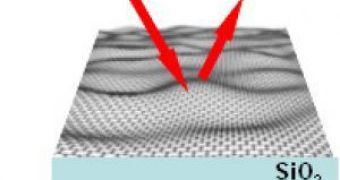With the help of one of the most powerful X-ray sources ever created by man, the Advanced Light Source housed at the Berkeley laboratory, researchers from the University of California, Columbia University and the Lawrence Berkeley National Laboratory have recently been able to reveal more of the properties of the wondrous material discovered four years ago, which we now call graphene.
Graphene is a carbon allotrope formed of carbon atoms disposed in a single layer in a hexagonal crystalline structure. It has exceptional thermal, electrical and optical properties, which makes it a leading candidate for the replacement of silicon inside current digital devices. For example, graphene could be used to replace the metal-oxide indium films in liquid crystal displays, since indium is extremely expensive and rare on Earth; the resources will probably be depleted in the next decade or so.
The problem with graphene is that very little is known about its optical and electrical properties, because spectroscopy techniques do not work on it. New investigations with the Advanced Light Source, capable of producing electromagnetic emission from infrared to X-ray, showed that electrons inside the graphene structure present strong interactions with the crystalline structure but also with other electrons.
"Infrared and optical experiments are capable of providing some of the most valuable insights into the electronic properties of materials, including interactions between electrons in a material. But it was extremely difficult to measure the absorption of light in a single monolayer of graphene, because not much light is absorbed. To do this, we had to start with a very bright light. It was spectroscopy to the extreme", said Dimitri Basov, a professor of physics at University of California, and leader of the study.
The light source at the Berkeley laboratory is one of the most powerful in the world and can produce X-ray emissions about 100 million times more powerful that those generated during a typical medical X-ray investigation. However, unlike the X-ray tube of the instruments used for medical investigations, the Advanced Light Source produces X-ray emissions by accelerating electrons at relativistic speeds.
"It took some difficult experimental work to make this measurement. It was by far the most complicated measurement we have ever done", Basov said.

 14 DAY TRIAL //
14 DAY TRIAL //